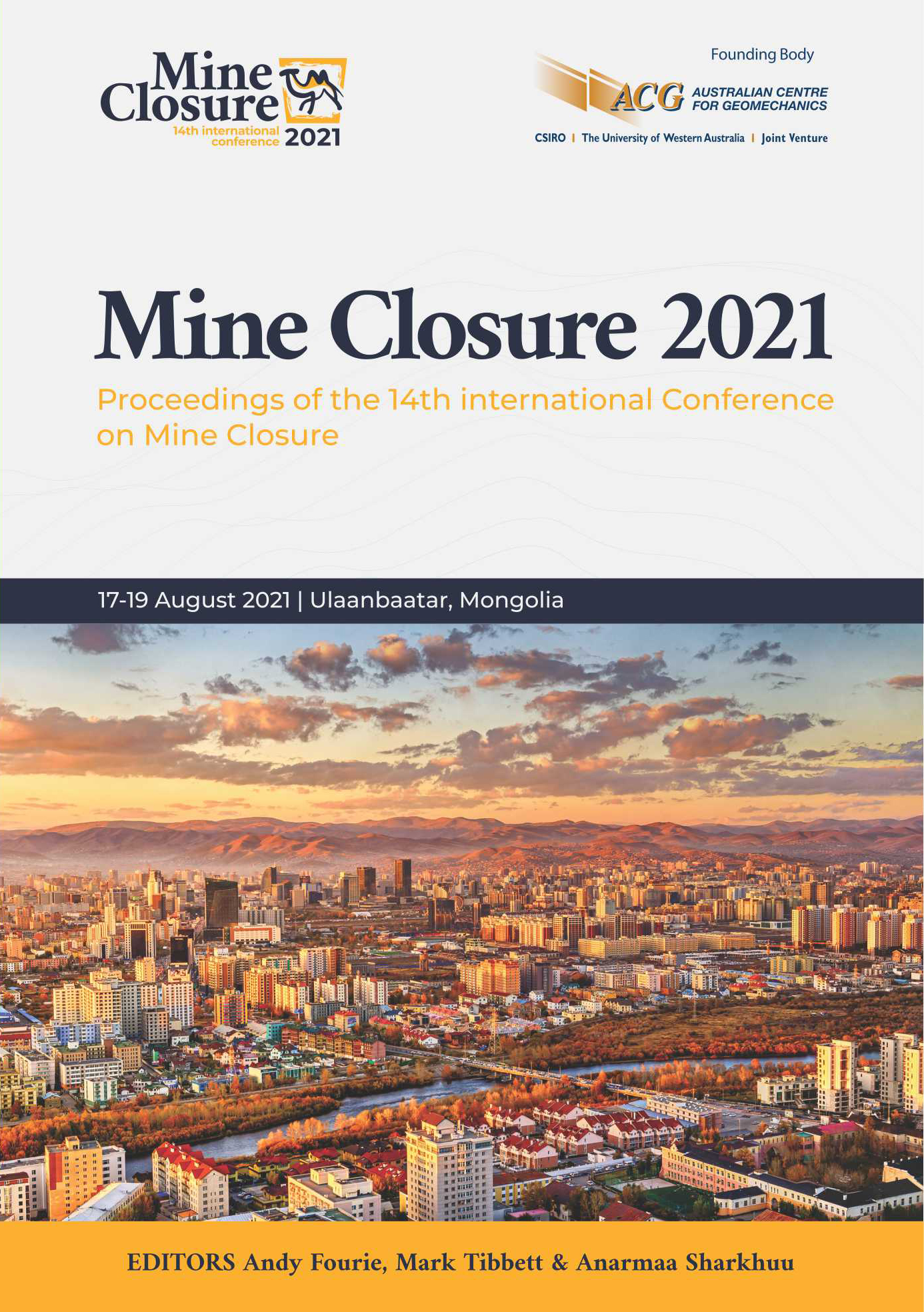Mine closure – do we miss the opportunities?

|
Authors: Bjelkevik, AG; Bohlin, TE |
DOI https://doi.org/10.36487/ACG_repo/2152_89
Cite As:
Bjelkevik, AG & Bohlin, TE 2021, 'Mine closure – do we miss the opportunities?', in AB Fourie, M Tibbett & A Sharkuu (eds), Mine Closure 2021: Proceedings of the 14th International Conference on Mine Closure, QMC Group, Ulaanbaatar, https://doi.org/10.36487/ACG_repo/2152_89
Abstract:
Mining operations have a big environmental impact wherever they are located. Unsuccessful operation and/ or inadequate planning for closure has in several cases increased the impact, causing costly environmental liabilities without finance. The consequence is, generalized, difficulties to get permits, in some countries more or less impossible. Metals and minerals are, however, necessary for our society and even more so with the “green transformation”, i.e. the change from fossil fuels to sustainable sources of energy (windmills, solar power, electrical cars etc. etc.). Mining has developed over centuries. With time, extraction processes have been refined resulting in a (still) increasing amount of waste materials, such as waste rock and tailings. The mining industry is the industry, globally, moving the largest volumes of materials. These materials are generalized a problem, a waste. Traditionally, mining operations are run by engineers using logic, “straight lines”, effective processes in order to produce good quality products. The waste materials produced have been, and still are, seen as a waste product, i.e. a problem to be solved as efficiently as possible at the lowest cost. Sometimes at a too low cost, which in the worst case may result in incidents or failures of tailings management facilities or inappropriate closure, none of them acceptable. This paper will discuss, from the authors point of view, possible ways of how mining operations may change into a positive element within our society. This require a new mindset and a different strategy within the industry. The authors believe this change could be to “use” mining, i.e. the materials produced, to create a value. By this many things can probably be achieved like; improved reputation, society/ community engagement, long term commitment and safer long-term solutions. The authors believe that these are key ingredients to obtain acceptance for the industry and more constructive permitting processes
References:
ANCOLD 2012, ‘Guidelines on Tailings Dams. Planning, design, construction, operation and closure’, Australian National Committee on Large Dams Incorporated, May 2012, ISBN: 978-0-9808192-4-3.
Australian Government 2016, ‘Tailings Management. Leading Practice Sustainable Development Program for the Mining Industry’, Australian Government, September 2016, industry.gov.au, dfat.gov.au, www.ag.gov.au.
Bjelkevik 2005, ‘Stability of tailings dams: focus on water cover closure’, Licentiate Thesis at Luleå University of Technology, Department of Civil and Environmental Engineering, Division of Geotechnology. 2005:85, ISSN: 1402-1757, ISRN: LTU-LIC -- 05/85 -- SE
CDA 2013, ‘Dam Safety Guidelines 2007 (2013 Edition)’, CDA/ACB Canadian Dam Association/Association Canadienne des Barrages, www.cda.ca, ISBN 978-0-9936319-0-0
EU 2018, ‘Best Available Techniques (BAT) Reference Document for the Management of Waste from Extractive Industries’ in accordance with Directive 2006/21/EC, European Union, JRC109657, EUR 28963 EN, PDF ISBN 978-92-79-77178-1, ISSN 1831-9424, Print ISSN 1018-5593, ISBN 978-92-79-77179-8, Luxembourg: Publications Office of the European Union, 2018,
GISTM 2020, ‘Global Industry Standard on Tailings Management’, Global Tailings Review, International Council on Mining & Metals (ICMM), UN Environment Programme (UNEP) and Principles for Responsible Investment (PRI), August 2020,
GruvRIDAS 2021, ‘GruvRIDAS – Gruvbranschens riktlinjer för dammsäkerhet, Guideline for Tailings Dam Safety’ The guideline is under ongoing revision with the main document to be published in 2021 and associated technical documents updated from 2021 and onwards (previous edition 2012). Svensk Energi AB / Svemin 2021,
GTR 2020, ‘Towards Zero Harm’ A compendium of papers prepared for the global tailings review, Chapter VIII Closure and Reclamation, Global Tailings Review, August 2020.
ICMM 2019, Integrated Mine Closure: Good practice guide (2nd edition, 2019), International Council on Mining & Metals, 2019,
ICOLD 2013, ICOLD Bulletin 153. ‘Sustainable Design and Post-Closure Performance of Tailings Dams’, International Commission on Large Dams, 61 avenue Kléber – Paris – 75116. www.icold-cigb.net
NV & SGU 2017:1, ’Förslag till strategi för hantering av gruvavfall. Redovisning av ett regeringsuppdrag’, Proposed strategy for an environmentally sustainable management of mining waste, Naturvårdsverket (NV), Environmental Protection Agency, och Sveriges geologiska undersökning (SGU), Geological Survey of Sweden, September 2017. Ärendenr: NV-03195-16, SGU: 311-888/2016
NV & SGU 2017:2, ’Delrapportering av regeringsuppdrag Strategi för hantering av gruvavfall’, Utvärdering av efterbehandlad gruvverksamhet, Naturvårdsverket (NV), Environmental Protection Agency, och Sveriges geologiska undersökning (SGU), Geological Survey of Sweden, March 2017, RR 2017:04, Ärendenr: NV-03195-16, SGU: 311-888/2016
RIR 2015, ’Gruvavfall – Ekonomiska risker för staten. En granskningsrapport från riksrevisionen RIR 2015:20’, Mine waste – Financial risks for the government. A review report by the Swedish National Audit Office, Stockholm 2015, ISBN 978-91-7086-389-9
Robertson et.al. 2019, ‘Report of the Expert Panel on the Technical Causes of the Failure of Feijão Dam I’. Expert panel: Peter K. Robertson, Ph.D. (Chair), Lucas de Melo, Ph.D., David J. Williams, Ph.D. and G. Ward Wilson, Ph.D. December 2019,
Sveriges Riksdag 1998, ’Miljöbalk’ (1998:808), The Environmental Code (1998:808), Sveriges Riksdag, Miljö- och energidepartementet, Swedish Parliament, Department of Environment and Energy June 1998,
Sveriges Riksdag 2013, ’Förordning om utvinningsavfall’ (SFS 2013:319), The Swedish Regulation on extraction of waste (SFS 2013:319), Sveriges Riksdag, Miljö- och energidepartementet, Swedish Parliament, Department of Environment and Energy, May 2013, /svensk-forfattnings samling /forordning-2013319-om-utvinningsavfall_sfs-2013-319
© Copyright 2026, Australian Centre for Geomechanics (ACG), The University of Western Australia. All rights reserved.
View copyright/legal information
Please direct any queries or error reports to repository-acg@uwa.edu.au
View copyright/legal information
Please direct any queries or error reports to repository-acg@uwa.edu.au
